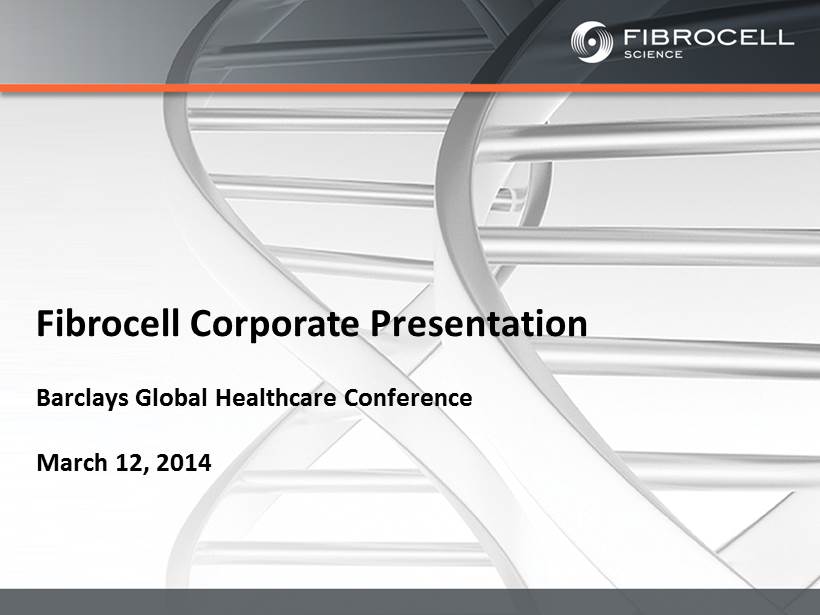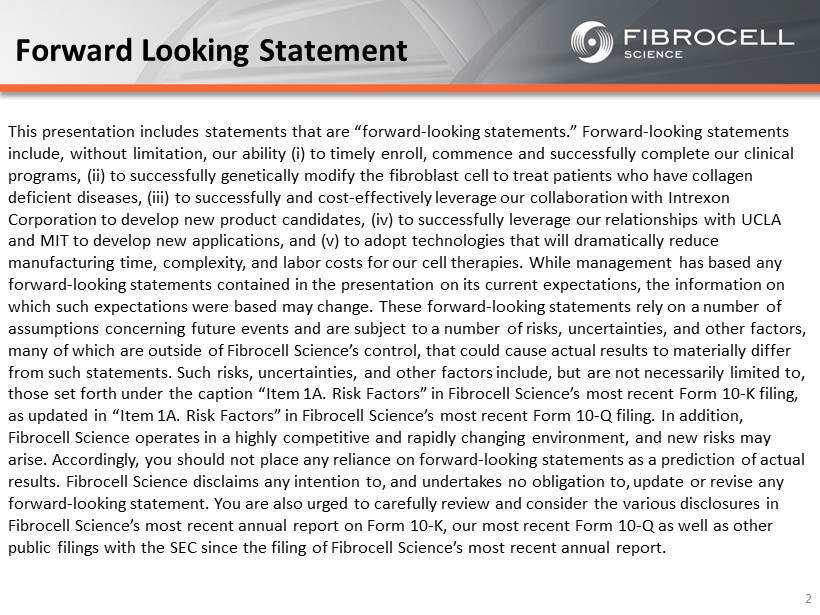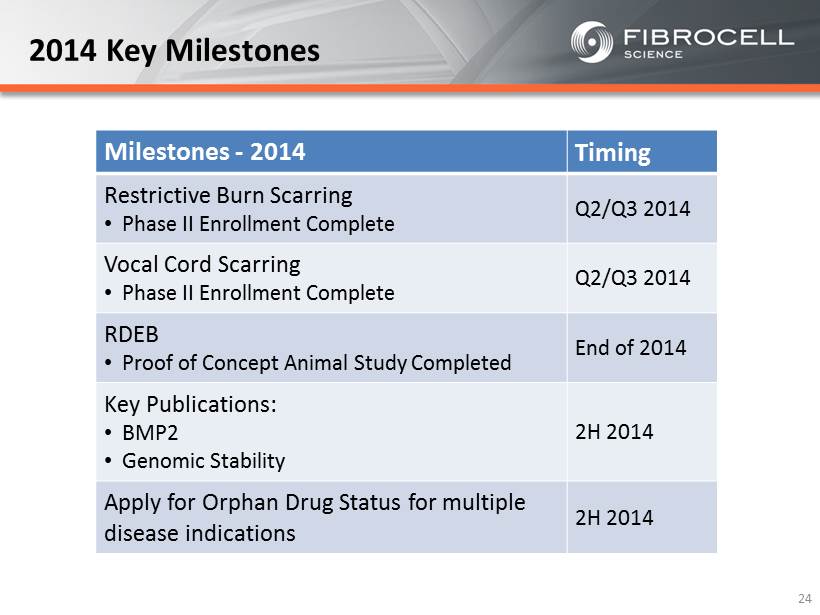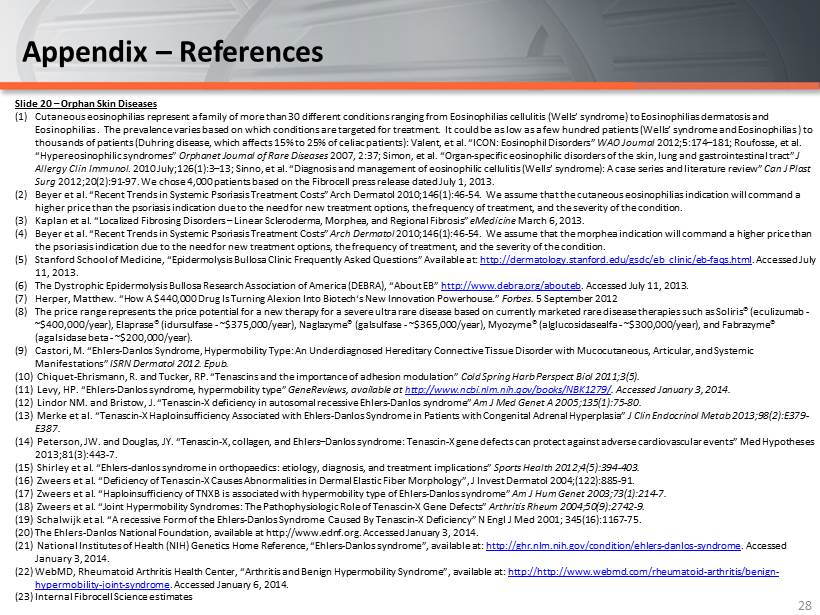Attached files
| file | filename |
|---|---|
| 8-K - FORM 8-K - Fibrocell Science, Inc. | v370942_8k.htm |

Fibrocell Corporate Presentation Barclays Global Healthcare Conference March 12, 2014

2 Forward Looking Statement This presentation includes statements that are “forward - looking statements.” Forward - looking statements include, without limitation, our ability ( i ) to timely enroll, commence and successfully complete our clinical programs, (ii) to successfully genetically modify the fibroblast cell to treat patients who have collagen deficient diseases, (iii) to successfully and cost - effectively leverage our collaboration with Intrexon Corporation to develop new product candidates, (iv) to successfully leverage our relationships with UCLA and MIT to develop new applications, and (v) to adopt technologies that will dramatically reduce manufacturing time, complexity, and labor costs for our cell therapies. While management has based any forward - looking statements contained in the presentation on its current expectations, the information on which such expectations were based may change. These forward - looking statements rely on a number of assumptions concerning future events and are subject to a number of risks, uncertainties, and other factors, many of which are outside of Fibrocell Science’s control, that could cause actual results to materially differ from such statements. Such risks, uncertainties, and other factors include, but are not necessarily limited to, those set forth under the caption “Item 1A. Risk Factors” in Fibrocell Science’s most recent Form 10 - K filing, as updated in “Item 1A. Risk Factors” in Fibrocell Science’s most recent Form 10 - Q filing. In addition, Fibrocell Science operates in a highly competitive and rapidly changing environment, and new risks may arise. Accordingly, you should not place any reliance on forward - looking statements as a prediction of actual results. Fibrocell Science disclaims any intention to, and undertakes no obligation to, update or revise any forward - looking statement. You are also urged to carefully review and consider the various disclosures in Fibrocell Science’s most recent annual report on Form 10 - K, our most recent Form 10 - Q as well as other public filings with the SEC since the filing of Fibrocell Science’s most recent annual report.

Investment Highlights • Fibrocell is the scientific and commercial leader in autologous fibroblasts for high - value human therapeutic applications • Leverage azficel - T BLA for multiple follow - on indications – Demonstrated ability to manufacture autologous therapy – Moderate to severe nasolabial fold wrinkles; safety database of > 1,000 patients • 2 clinical stage development sBLA programs: azficel - T to treat restrictive burn scarring and vocal cord scarring – Phase II results anticipated in 2015 • Strategic collaboration with Intrexon Corporation (NYSE: XON) – Focused on genetically - modified autologous fibroblast cells – Multiple orphan skin and connective tissue disease indications in late pre - clinical • $64 million cash position as of October 2013 with no debt 3

The Leader in Autologous Fibroblasts • The scientific and commercial leader in autologous fibroblasts, the most common cells in connective tissue − Localized drug delivery advantage − Autologous cells reduce risk of patient rejection − Unique expertise in collection and cultivation of fibroblasts • Proprietary technology used to create personalized biologics - derived from a patient’s own cells to treat rare skin and connective tissue diseases • Fibroblast therapeutics may confer significant benefit to many disease states and injuries such as: − Restrictive burn scarring − Vocal cord scarring − Genetic disorders of the skin and connective tissue 4

Strategic Focus: Leveraging the Potential of Our Autologous Fibroblast Platform Autologous Fibroblasts • Restrictive Burn Scarring • Vocal Cord Scarring • Recessive Dystrophic Epidermolysis Bullosa (RDEB) • Tenascin - X • Morphea Profunda /Linear Scleroderma • Cutaneous Eosinophilias Genetically - Modified Human Fibroblasts Azficel - T approved BLA - Label extension strategy 5

Two Product Engines – Multiple Therapeutics in Development 6 2 • Unique capabilities to treat unmet skin disease targets • Rare disease programs leverage Intrexon synthetic biology tools • Patent protected, diversified product pipeline

Indication 2014 2015 2016 Restrictive Burn Scarring Vocal Cord Scarring Recessive Dystrophic Epidermolysis Bullosa (RDEB) Morphea Profunda / Linear Scleroderma Cutaneous Eosinophilias Tenascin - X Phase II Primary Endpoint Phase II Primary Endpoint Product Optimization and PoC Studies; Pre - Clinical Phase III Phase III BLA Phase I Phase I Phase II/III 7 Phase I Product Optimization and PoC Studies/Pre - Clinical Product Optimization and PoC Studies/Pre - Clinical Product Optimization and PoC Studies/Pre - Clinical Development Pipeline Phase I BLA Intrexon Synthetic Biology Rare Disease Programs Azficel - T sBLA Programs

Importance of BLA for azficel - T • Label Expansion – high value opportunities near term – Leveraging established proof of concept and extensive clinical experience • Two clinical stage development programs – Phase II Restrictive Burn Scarring – Phase II Vocal Cord Scarring • Demonstrated ability to manufacture autologous therapeutics across product candidates • BLA approved in 2011 for moderate to severe nasolabial fold wrinkles in adults 8

9 Scarring: azficel - T Label Extensions Fibrocell Scarring Pipeline: Estimated Market Opportunity • Restrictive Burn Scarring (U.S. only) - 40,000 hospitalized burn victims in 2012 (1) - Total excludes military burn injuries - Addressable Patient Population: - 25% treated (2) - Pool of patients available includes previous 3 years - Current treatment options include surgery, physical therapy (1) American Burn Association http://www.ameriburn.org / (2) Fibrocell internal estimates (3) Cohen, (2010); Dailey et al. (2007); Roy et al. (2005); Poels et al. (2003); Koufman and Isaacson (1991); Painter (1990); Bou cha yer et al. (1985); Laguaite (1972) • Vocal Cord Scarring (U.S. only) - 200,000 - 700,000 patients with VCS (3) - Current treatment options limited to surgery and voice therapy $ 776 $- $100 $200 $300 $400 $500 $600 $700 $800 $900 In $ Millions Vocal Cord Scarring Burn Scarring $240 - 840

Restrictive Burn Scarring Overview 10 (1) www.ameriburn.org; Goodis . J and E.d . Schraga . Burns, thermal. eMedicine Journal (2) American Burn Association. National Burn Repository®. 2012 Report. Dataset Version 8.0. Data collected from reporting burn fa cil ities over a ten year period (Jan 2002 – Jan 2011). Patient total: 140,009 • Opportunity is to treat mobility limitations created by burn scar tissue − Typically at the shoulder, elbow, wrist, knee • No FDA approved therapeutics − Current therapies include surgery − 40,000 or more yearly hospitalizations for severe burns (1) • Focused market opportunity: 60% of cases treated at 127 U.S. burn centers • Extent of burn injury: 90% of burn patients experience burns on < 20% of TBSA (2)

Pre - Treatment 12 Mo Post - Treatment • Full range - clench 14 Mo Post - Treatment • Fine finger movement Six Months Post Treatment (2) : • Full range of neck rotation, and pain free • Patient has stopped all analgesics • Discarded cervical collar (1) (1) Inglefield, C. BSc , FRCS( Plast ). An Open - label Case Experience with Autologous Fibroblast Therapy (AT) in the Management of Burn Scars; Poster Presented at AA D Jan 2008 (2) Case Study Photographs; Courtesy of Chris Inglefield Restrictive Burn Scarring Results from Open - Label Case Studies 11 Before After

• Trial Initiated • Multi - center trial: 8 major centers anticipated • Double - blind, randomized, placebo - controlled, 21 subjects (up to 30) • 6 month efficacy endpoint: Results expected 2015 • Subjects inclusion criteria: − Unilateral restrictive burn scars of a jointed area − 20 - 60% restriction in normal range of motion • FDA Agreed - upon Validated Measurement Scales: − Range of Motion Measurement (1) − Brief Pain Index (BPI) (2) − Scar Appearance – Vancouver Scar Scale (3) Restrictive Burn Scarring Phase II 12 (1) Standard ROM measuring techniques (Parry, et al 2010) (2) Brief Pain Inventory (BPI) numerical scale (0 to 10) ( Cleeland and Ryan 1994; Tan, et al 2004) (3) Vancouver Scar Scale ( Baryza and Baryza 1995; Nedelec, et al 2000)

• Positive pilot study results published in peer - reviewed journal The La ryngoscope , 2011 (1) − Azficel - T well - tolerated when injected into vocal folds; n=5 − Improvements lasted up to one year − Findings supported by mucosal wave grade, voice handicap index, and voice quality questionnaire (1) Chhetri, Dinesh, Injection of Cultured Autologous Fibroblasts for Human Vocal Fold Scars. The Laryngoscope 121(4):785 - 792, 2011 Vocal Cord Scarring Overview & Phase I 13 • No FDA approved therapeutics • Most commonly encountered finding is loss of voice − Due to surgery, radiation therapy, vocal cord trauma and idiopathic causes − Treatment options include surgery, voice therapy

• Trial initiated • Multi - center trial: 3 major centers anticipated • Double - blind, randomized, placebo - controlled, 20 subjects (up to 30) • 4 month efficacy endpoint: Results expected 2015 • Subject inclusion criteria : ₋ Presence of unilateral or bilateral vocal fold scarring or age - related dysphonia ₋ Failed other voice treatments ₋ Feels their voice quality is a major handicap • FDA Agreed - upon Validated Study Endpoints: − Absolute change from baseline in mucosal wave grade using videostroboscopy − Absolute and % change from baseline in the Voice Handicap Index (VHI) (1) − Perceptual analysis using the GRBAS scale ( G rade of dysphonia, R oughness, B reathiness, A sthenia, S train) (2) Vocal Cord Scarring Phase II 14 (1) Jacobson BH, Johnson A, Grywalski A et al. The Voice Handicap Index: Development and validation. J Voice 1998;12:540 - 50. (2) Karnell MP, Melton SD, Childes JM et al. Reliability of clinician - based (GRBAS and CAPE - V) and patient - based (V - RQOL and IPVI) documen tation of voice disorders. J Voice 2007;21:576 - 90 .

The Power of the Intrexon Collaboration Autologous Fibroblast Expertise Synthetic Biology Platform Autologous gene - modified fibroblasts enable delivery & production of a disease - modifying protein locally v. systemically 15

Design • Multiple rare disease indications • Genetically - modified autologous fibroblasts with therapeutic gene(s) of interest for the localized treatment of skin and connective tissue diseases addressing the underlying cause of these diseases and providing relief of symptoms • Advantages - Targeting therapeutic at lesion site – a more responsive approach - Reduce rejection concern; provide more controlled delivery Intrexon Collaboration Highlights 16 Att Site® RheoSwitch® Enzyme Inhibitor LS CP Gene Program (single gene or multigenic ) Growth Factor UE TL IP Vector Backbon e Analytically Modular DNA Assembly Line UltraVector ® Platform Build Test Learn © 2013 Intrexon Corp. All rights reserved.

Rare Skin Diseases: Orphan Market Opportunities 17 Orphan Indication Estimated U.S. Prevalence Recessive Dystrophic Epidermolysis Bullosa (RDEB) 2,800 - 5,600 Tenascin - X 2,000 - 6,000 Morphea Profunda /Linear Scleroderma ~10,000 Cutaneous Eosinophilias ~4,000 References – See Appendix on Slide 29

RDEB: Unique Approach to Localized Treatment of Rare Skin Disease 18 • Symptoms: Blisters over widespread areas of the body • Cause: A mutation in the COL7A1 gene which encodes for type VII collagen – the main component of connective and fibrous tissues • Proposed Drug Candidate: G enetically - modified autologous fibroblast – - Transfected with a plasmid vector containing the gene for COL7A1 - Upregulated to produce collagen VII in a controlled manner - Local delivery of missing gene

Tenascin - X Deficiency • Tenascin - X is an extracellular matrix glycoprotein found in loose connective tissue, a deficiency of which causes a hyper - mobility disorder that can create significant disability in patients • Tenascin - X helps determine how collagen fibrils are deposited in the extracellular matrix of joints, organs, and skin, regulating the structure and stability of elastic fibers • Mutation in the gene reduces the level of tenascin - X, leading to disorganization of these connective fibers in skin, ligaments and tendons • The autologous fibroblast cell is the mechanism delivering the gene, to potentially correct the diseased condition at the local target area 19

Intrexon RheoSwitch Therapeutic System®: Key for Autoimmune Diseases Att Site® RheoSwitch® Enzyme Inhibitor LS CP Gene Program (single gene or multigenic) Growth Factor UE TL IP Vector Backbone ● Intrexon Corp. proprietary on/off biologic switch, incorporated into an UltraVector® designed vector ● Three - component transcriptional regulator that provides inducible gene expression ● Maintains gene program in inactive state until application of a compound containing a small molecule ligand ● Ability to not only express proteins/enzymes, but also ability to control level and timing of expression ● Demonstrated highly controllable expression both in vivo and ex vivo © 2013 Intrexon Corp. All rights reserved. 20

Autoimmune Skin Diseases – Localized Treatment 21 • Rare and serious orphan autoimmune diseases that manifest on the skin – Morphea Profunda /Linear Scleroderma • Underlying cause is accumulation of collagen – Cutaneous Eosinophilias • Underlying cause of inflammation is accumulation of eosinophils • Localized treatment avoids impact to the immune system as a whole • Proposed drug candidates: – Genetically - modified fibroblast using vector designed with a gene controlled by Intrexon’s RheoSwitch Therapeutic System® (RTS®) Technology – Topical activator directed at target site allows for localized vs. systemic treatment

UCLA Research Collaboration • M ulti - year research collaboration with UCLA • Programs use Fibrocell autologous fibroblast skin cell technologies • Funded partially through government CIRM grants • Anticipate peer - reviewed publications in 2014/2015 • Bone Morphogenetic Protein (BMP2) – Osteogenic therapeutic research towards potential biologic solution to orthopedics – Evaluating use of genetically - modified fibroblasts to produce BMP2 for bone repair – Controlled release, improved safety features • Genomic Stability Media Development – Essentially all iPSC clones derived using current approaches, acquire genomic instability during reprogramming and in vitro culture - induced stress – Lack of genomic stability creates a hurdle for iPSC therapeutic development 22

• Cash position ~$64 million following October 2013 financing • $50.5 million gross proceeds from underwritten offering • Quarterly average use of cash: $6 - 7 million • 40.9 million shares outstanding - 6.0 million warrants; 2.3 million options • Clean capital structure • Analyst research: - Ying Huang — Barclays - Greg Wade – Wedbush - Keith Markey — Griffin Financial Information 23

2014 Key Milestones 24 Milestones - 2014 Timing Restrictive Burn Scarring • Phase II Enrollment Complete Q2/Q3 2014 Vocal Cord Scarring • Phase II Enrollment Complete Q2/Q3 2014 RDEB • Proof of Concept Animal Study Completed End of 2014 Key Publications: • BMP2 • Genomic Stability 2H 2014 Apply for Orphan Drug Status for multiple disease indications 2H 2014

Milestones - 2015 Restrictive Burn Scarring • Phase II Results Vocal Cord Scarring • Phase II Results RDEB • IND Filed & Phase I Results Morphea Profunda /Linear Scleroderma • Pre - Clinical Development Cutaneous Eosinophilias • Pre - Clinical Development Tenascin - X • Pre - Clinical Development 2015 Key Milestones 25

• NYSE MKT: FCSC • Market Cap: ~$225 million as of 3/6/2014 • HQ facility: Exton, PA • ~60 employees • Management Team – development, manufacturing and commercial experience David Pernock, CEO & Chairman of the Board − Previously SVP at GlaxoSmithKline Greg Weaver, SVP & CFO − Previously CFO at Celsion, Poniard, Sirna , ILEX Robert Sheroff , VP of Technical Operations − Previously SVP at Biogen Idec; VP at J&J, Centocor , Warner Lambert John Maslowski, VP of Scientific Affairs − Previously at Wyeth Pharmaceuticals Laura Campbell, VP of HR & Business Process − Previously at GlaxoSmithKline Corporate Profile 26

Investment Highlights • Fibrocell is the scientific and commercial leader in autologous fibroblasts for high - value human therapeutic applications • Leverage azficel - T BLA for multiple follow - on indications – Demonstrated ability to manufacture autologous therapy – Moderate to severe nasolabial fold wrinkles; safety database of > 1,000 patients • 2 clinical stage development sBLA programs: azficel - T to treat restrictive burn scarring and vocal cord scarring – Phase II results anticipated in 2015 • Strategic collaboration with Intrexon Corporation (NYSE: XON) – Focused on genetically - modified autologous fibroblast cells – Multiple orphan skin and connective tissue disease indications in late pre - clinical • $64 million cash position as of October 2013 with no debt 27

Appendix – References Slide 20 – Orphan Skin Diseases (1) Cutaneous eosinophilias represent a family of more than 30 different conditions ranging from Eosinophilias cellulitis (Wells’ syndrome) to Eosinophilias dermatosis and Eosinophilias . The prevalence varies based on which conditions are targeted for treatment. It could be as low as a few hundred patients (W ells’ syndrome and Eosinophilias ) to thousands of patients ( Duhring disease, which affects 15% to 25% of celiac patients): Valent , et al. “ICON: Eosinophil Disorders” WAO Journal 2012;5:174 – 181; Roufosse , et al. “ Hypereosinophilic syndromes” Orphanet Journal of Rare Diseases 2007, 2:37; Simon, et al. “Organ - specific eosinophilic disorders of the skin, lung and gastrointestinal tract” J Allergy Clin Immunol . 2010 July;126(1):3 – 13; Sinno , et al. “Diagnosis and management of eosinophilic cellulitis (Wells’ syndrome): A case series and literature review” Can J Plast Surg 2012;20(2):91 - 97. We chose 4,000 patients based on the Fibrocell press release dated July 1, 2013. (2) Beyer et al. “Recent Trends in Systemic Psoriasis Treatment Costs” Arch Dermatol 2010;146(1):46 - 54. We assume that the cutaneous eosinophilias indication will command a higher price than the psoriasis indication due to the need for new treatment options, the frequency of treatment, and the sev eri ty of the condition. (3) Kaplan et al. “Localized Fibrosing Disorders – Linear Scleroderma, Morphea, and Regional Fibrosis” eMedicine March 6, 2013. (4) Beyer et al. “Recent Trends in Systemic Psoriasis Treatment Costs” Arch Dermatol 2010;146(1):46 - 54. We assume that the morphea indication will command a higher price than the psoriasis indication due to the need for new treatment options, the frequency of treatment, and the severity of the condi tio n. (5) Stanford School of Medicine, “ Epidermolysis Bullosa Clinic Frequently Asked Questions” Available at: http://dermatology.stanford.edu/gsdc/eb_clinic/eb - faqs.html . Accessed July 11, 2013. (6) The Dystrophic Epidermolysis Bullosa Research Association of America (DEBRA), “About EB” http://www.debra.org/abouteb . Accessed July 11, 2013. (7) Herper , Matthew. “How A $440,000 Drug Is Turning Alexion Into Biotech‘s New Innovation Powerhouse.” Forbes. 5 September 2012 (8) The price range represents the price potential for a new therapy for a severe ultra rare disease based on currently marketed rar e disease therapies such as Soliris ® ( eculizumab - ~$400,000/year), Elaprase ® ( idursulfase - ~$375,000/year), Naglazyme ® ( galsulfase - ~$365,000/year), Myozyme ® ( alglucosidasealfa - ~$300,000/year), and Fabrazyme ® ( agalsidase beta - ~$200,000/year). (9) Castori , M. “Ehlers - Danlos Syndrome, Hypermobility Type: An Underdiagnosed Hereditary Connective Tissue Disorder with Mucocutaneous , Articular , and Systemic Manifestations” ISRN Dermatol 2012. Epub . (10) Chiquet - Ehrismann , R. and Tucker, RP. “ Tenascins and the importance of adhesion modulation” Cold Spring Harb Perspect Biol 2011;3(5). (11) Levy, HP. “Ehlers - Danlos syndrome, hypermobility type” GeneReviews , available at http://www.ncbi.nlm.nih.gov/books/NBK1279/ . Accessed January 3, 2014. (12) Lindor NM. and Bristow, J. “ Tenascin - X deficiency in autosomal recessive Ehlers - Danlos syndrome” Am J Med Genet A 2005;135(1):75 - 80. (13) Merke et al. “ Tenascin - X Haploinsufficiency Associated with Ehlers - Danlos Syndrome in Patients with Congenital Adrenal Hyperplasia” J Clin Endocrinol Metab 2013;98(2):E379 - E387. (14) Peterson, JW. and Douglas, JY. “ Tenascin - X, collagen, and Ehlers – Danlos syndrome: Tenascin - X gene defects can protect against adverse cardiovascular events” Med Hypotheses 2013;81(3):443 - 7. (15) Shirley et al. “Ehlers - danlos syndrome in orthopaedics : etiology, diagnosis, and treatment implications” Sports Health 2012;4(5):394 - 403. (16) Zweers et al. “Deficiency of Tenascin - X Causes Abnormalities in Dermal Elastic Fiber Morphology”, J Invest Dermatol 2004;(122):885 - 91. (17) Zweers et al. “ Haploinsufficiency of TNXB is associated with hypermobility type of Ehlers - Danlos syndrome” Am J Hum Genet 2003;73(1):214 - 7. (18) Zweers et al. “Joint Hypermobility Syndromes: The Pathophysiologic Role of Tenascin - X Gene Defects” Arthritis Rheum 2004;50(9):2742 - 9. (19) Schalwijk et al. “A recessive Form of the Ehlers - Danlos Syndrome Caused By Tenascin - X Deficiency” N Engl J Med 2001; 345(16):1167 - 75. (20) The Ehlers - Danlos National Foundation, available at http://www.ednf.org. Accessed January 3, 2014. (21) National Institutes of Health (NIH) Genetics Home Reference, “Ehlers - Danlos syndrome”, available at: http://ghr.nlm.nih.gov/condition/ehlers - danlos - syndrome . Accessed January 3, 2014. (22) WebMD, Rheumatoid Arthritis Health Center, “Arthritis and Benign Hypermobility Syndrome”, available at: http://http://www.webmd.com/rheumatoid - arthritis/benign - hypermobility - joint - syndrome . Accessed January 6, 2014. (23) Internal Fibrocell Science estimates 28
